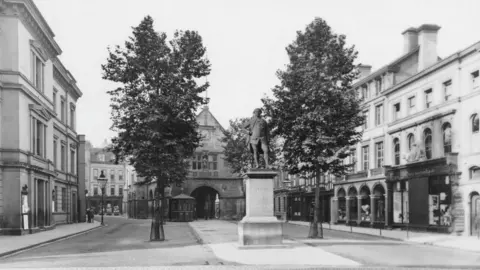‘Robert Clive has been sort of forgotten in India’
 Karla Gowlett
Karla GowlettAn Indian comedian has said controversial figure Robert Clive’s has been largely “forgotten” in India.
It comes after a prominent member of the House of Lords called for a statue of Clive to be taken down from outside the Foreign Office in London, sparking debate.
Clive, born near Market Drayton, is widely credited with engineering British colonial rule in India, and has been linked by some historians to the Bengal Famine of 1770, which saw millions die.
“Obviously by modern morality he was a thief and a criminal and all of those things, but in India it’s quite fascinating, because a lot of people have just moved on from the empire,” said comedian Anuvab Pal.
Baroness Debbonaire said the statue outside the Foreign Office was historically inaccurate and unhelpful to Britain’s relations with India.
A similar statue has stood in Shrewsbury’s town square since 1860, although an information board was added in 2023 to explain Clive’s polarising past.
Looting was widespread as the East India Company brought more parts of the country under British control and while millions died in the [Bengal] famine, Clive returned to Britain a wealthy man.
 Getty Images
Getty ImagesPal created a show around the legacy of the British Empire, and visited Shropshire to speak about Clive.
“The great irony is that there’s a massive statue of Clive very close to my house where I live in Kolkata… which just got repainted,” he told the BBC.
“No-one knows who this is, so they put a plaque at the bottom saying: ‘Prominent Englishman’.”
He added that a statue of Clive in the Victoria Memorial in Kolkata was moved to a different area, instead of being removed entirely.
“Clive, whose legacy is much debated in Britain, is sort of forgotten but also not entirely removed in India,” he said.
“You can’t wipe away history… I understand going back and looking at the morality of people and saying: This guy’s a crook this, guy’s a criminal’, fair enough.
“But you can’t take away the fact that 250 years of this has shaped a whole different country, and it’s just seeped into their culture.”
 Hulton Archive via Getty Images
Hulton Archive via Getty ImagesThe Shrewsbury statue became mired in controversy in 2020.
Two petitions with 23,000 signatures were sent to the council calling for the statue to be removed and a third, with 8,000 signatures, saying removing it would erase part of the town’s history.
Debate over his presence followed a wave of anti-racism protests in the UK that year in light of the death of George Floyd, the black American who died in the custody of Minneapolis police.
Shropshire Council decided to keep the statue but voted for an interpretation board to be installed next to it.
‘Shrewsbury has got it right’
Historian and author William Dalrymple said he believed Shrewsbury had “got it right” in regards to keeping the statue.
“There’s a very good plaque… which explains both sides, the things he did that enriched us, however much we may regard them as war crimes today, and to give the information about why he was regarded as such a controversial character,” he told the BBC.
He said that even during the time he was alive, people thought Clive to be controversial.
“This isn’t some sort of modern woke rewriting of history,” he said.
“In Shropshire and in London, the local papers are full of accusations of him looting, plundering, raping and creating mayhem in the countries that he was involved in.
“He was hissed and booed in the streets of London and eventually took his own life.”
Follow BBC Shropshire on BBC Sounds, Facebook, X and Instagram.
